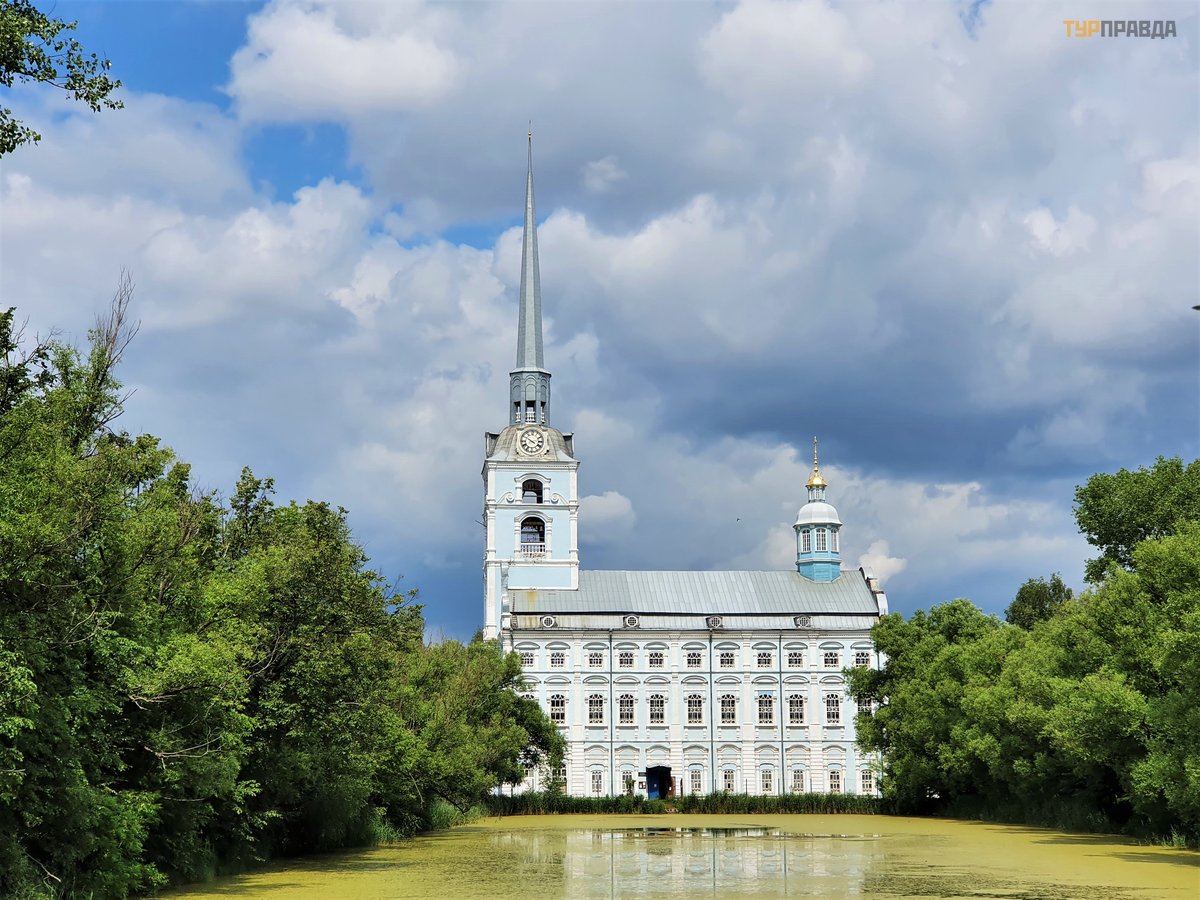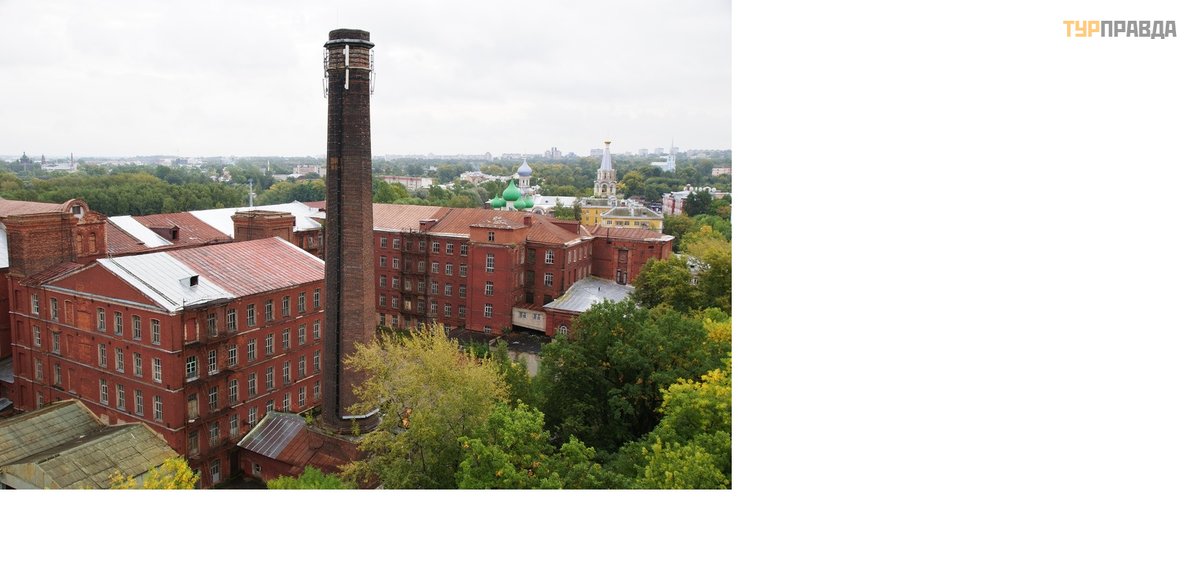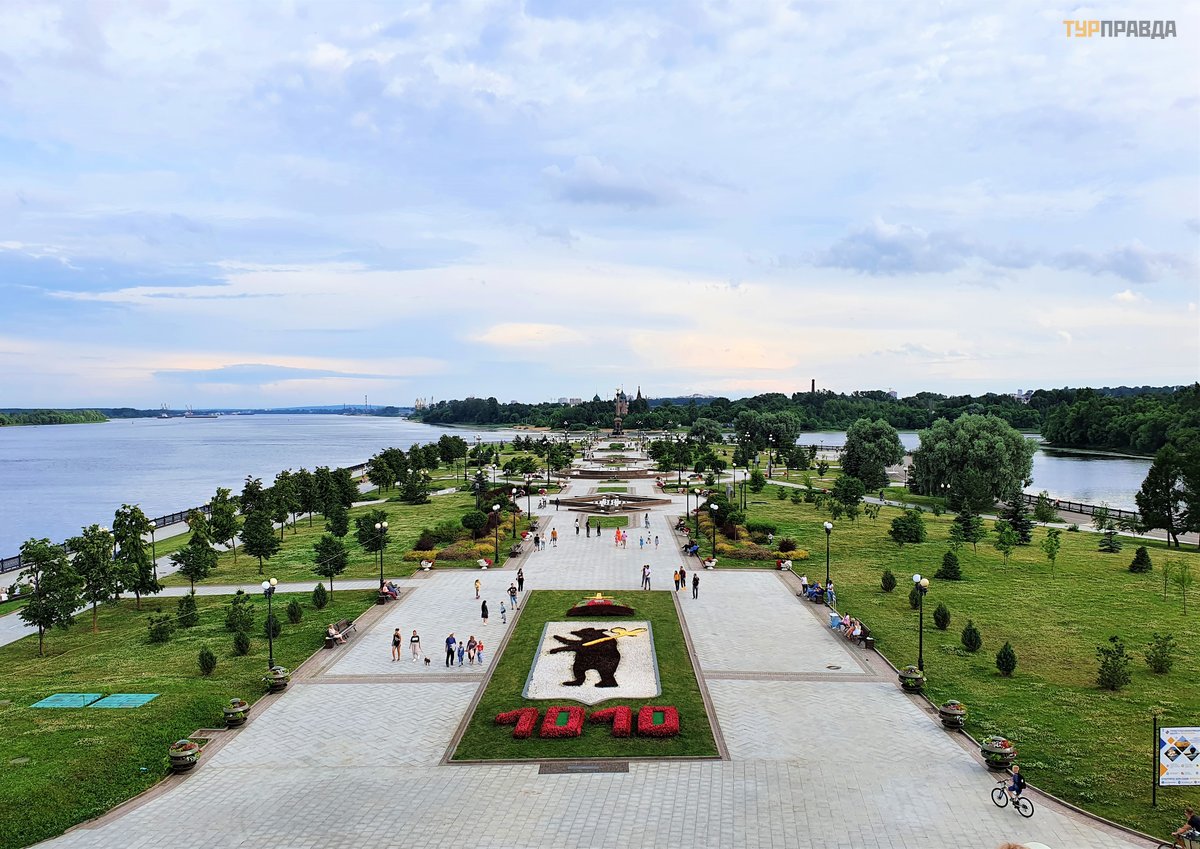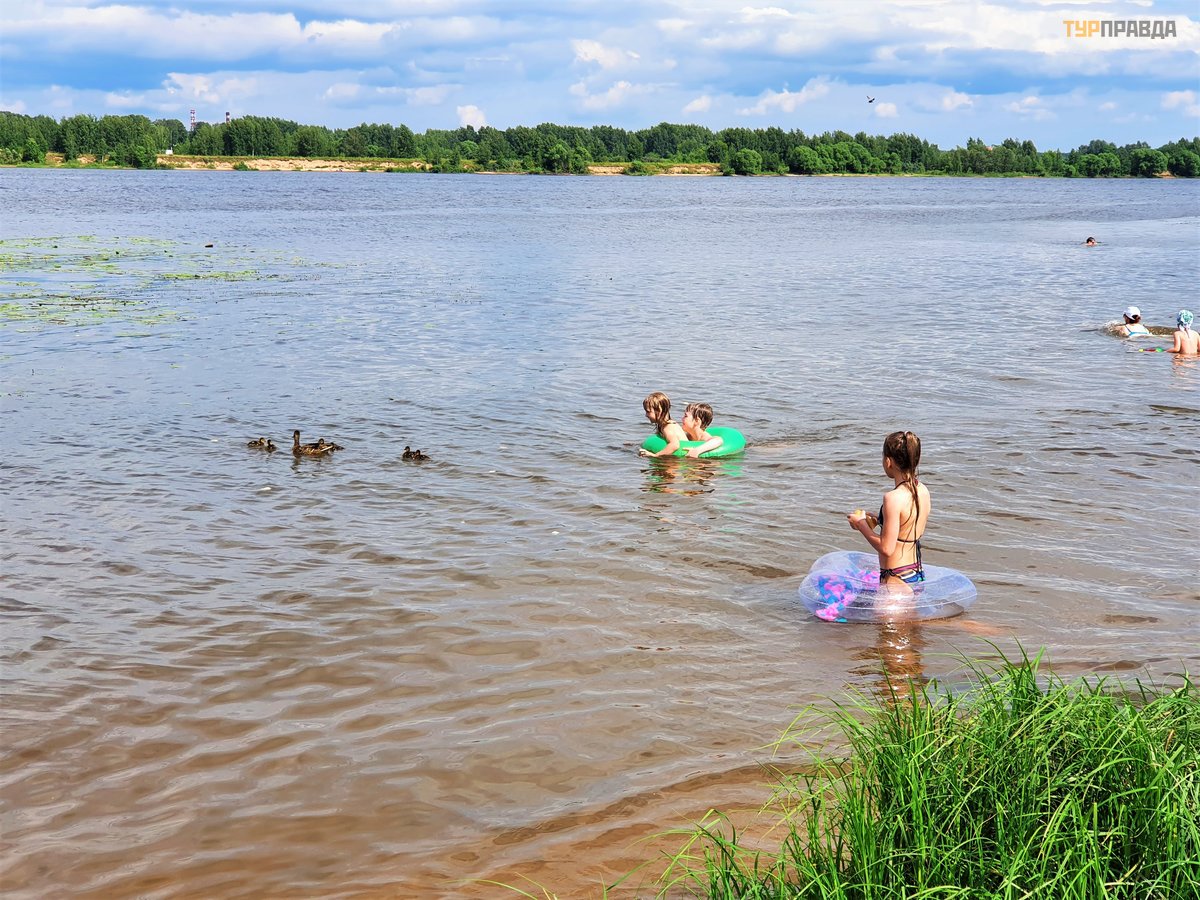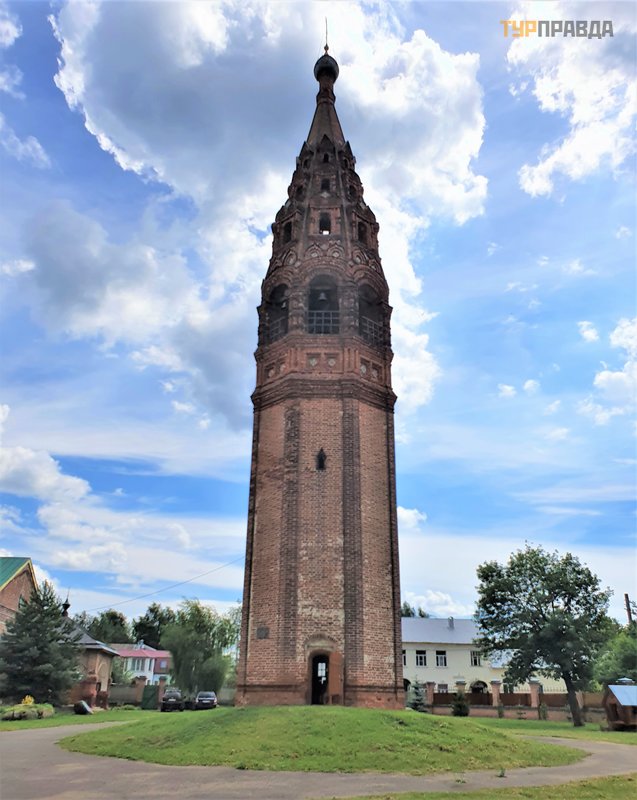Yaroslavl. The opening of the seasons after the great sitting. Part 2. Routes ... uh ... not shabby
SHELLY, -th, -th; -zen, -zna (colloquial). Everyday, everyday; worn. Ozhegov's Explanatory Dictionary. S. I. Ozhegov, N. Yu. Shvedova. 1949-1992.
Yaroslavl. The opening of the seasons after the great sitting. Part 1. Standard routes >>>
Since we are by car, the next day was devoted to the study of Yaroslavl sights, which are not within walking distance from the historical center of Yaroslavl. Therefore, few tourists wander into those Zakotorosl lands - on the right bank of the Kotorosl River.
Historically, settlements and settlements were formed there, specializing in some kind of craft. Later, manufactories were created. We went to look for traces of Yaroslavskaya Bolshaya Manufactory, which began its history from the decree of Peter I on the creation of linen production in Yaroslavl in 1722. During the period of rapid industrial development in the 19th century, entire towns with residential buildings, schools and hospitals were built in the immediate vicinity of the workshops. Last year in Tver, a similar town of the Morozovskaya manufactory, now the Proletarka district, made a huge impression on us (there are records about that event "Tver. So different"). So, having seen similar Internet pictures about Yaroslavl, we decided to support the nascent rudiments of industrial tourism, so to speak. Since this plan was planned on the go during breakfast, they did not pay attention to the study of this part of the route. We chose Peter and Paul Church (1736-1744), built on the territory of the manufactory according to image and likeness of the Peter and Paul Church in St. Petersburg and preserved to this day.
Not far from the temple, there were overgrown ruins made of red brick with a sign that this was once the building of the same manufactory. Strangely, the pictures were quite living buildings. For some reason, the cards didn’t show us anything on the request “manufactory” in different variations, and there was no one to ask, no one in the district at all. Now I understand that we went to the wrong places a little, the Yaroslavl Big Manufactory occupied vast territories. In Soviet times, all this economy was transformed into Krasny Perekop plant, which still exists today. Apparently, these areas have not yet been tested by crazy tourists, like us, at least not in large numbers. Here are the cards and do not know where to send. Well, we did not balk, there were a lot of plans. So industrial tourism failed, there is a reason to return)).
By the way, an interesting fact: it is the Yaroslavl Big Manufactory that is the birthplace, the place of origin of the word "shabby", hence the phrase "shabby look". The manufactory produced a variety of fabrics, both expensive for the royal court or for export abroad, as well as cheap, but durable fabrics that were loved by the common population. The design, as they would say now, was not the brightest and most beautiful, and they were called shabby - by the name of the creator of the manufactory, Ivan Maksimovich Zatrapeznikov. Since then, it has gone: everything that is not smart, shabby has become called shabby.
The Yaroslavl industrial zone keeps many wonders. One of these is the Church of the Beheading of John the Baptist in Tolchkovo, lost in the wilds of the Russian Paints paint and varnish factory. At first we thought that the navigator, as usual, decided to play pranks and led us somewhere in the wrong direction - a concrete fence under the bridge, impassable thickets... But then, like in a fairy tale, a cleared clearing opened up, and in the middle a miraculous marvelous.
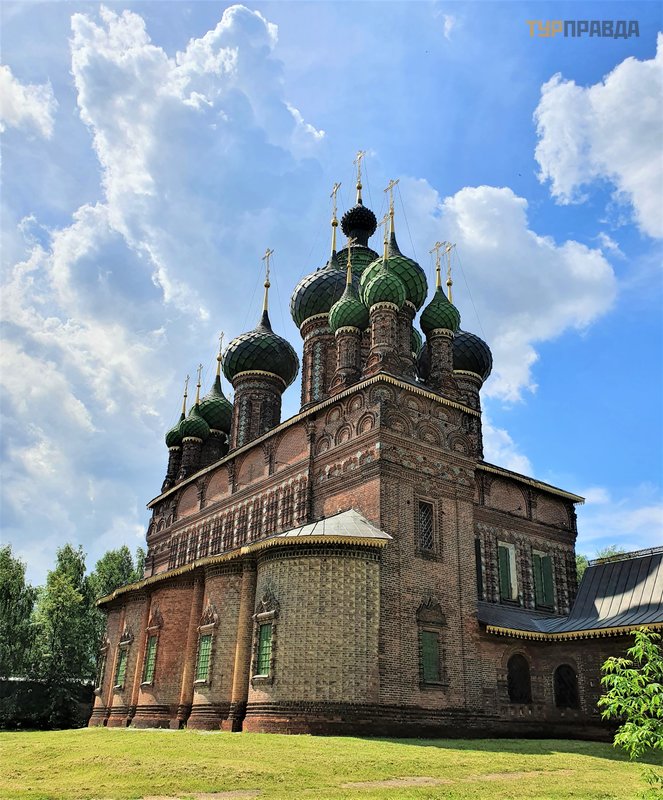 Church of the Beheading of John the Baptist in Tolchkovo
Church of the Beheading of John the Baptist in Tolchkovo
This temple is depicted on the thousandth bill of the Russian Federation, chosen as a symbol of the beauty and uniqueness of Russian architecture. But I have already talked about it in detail in review of the “thousandth” beauty of Yaroslavl” . If you missed it, take a look.
And another pearl of Yaroslavl hides beauty and splendor from tourist crowds, only teasing with its views from Strelka. . .
. . . or from cruise ships sailing along the Volga - the temple complex in Korovniki.
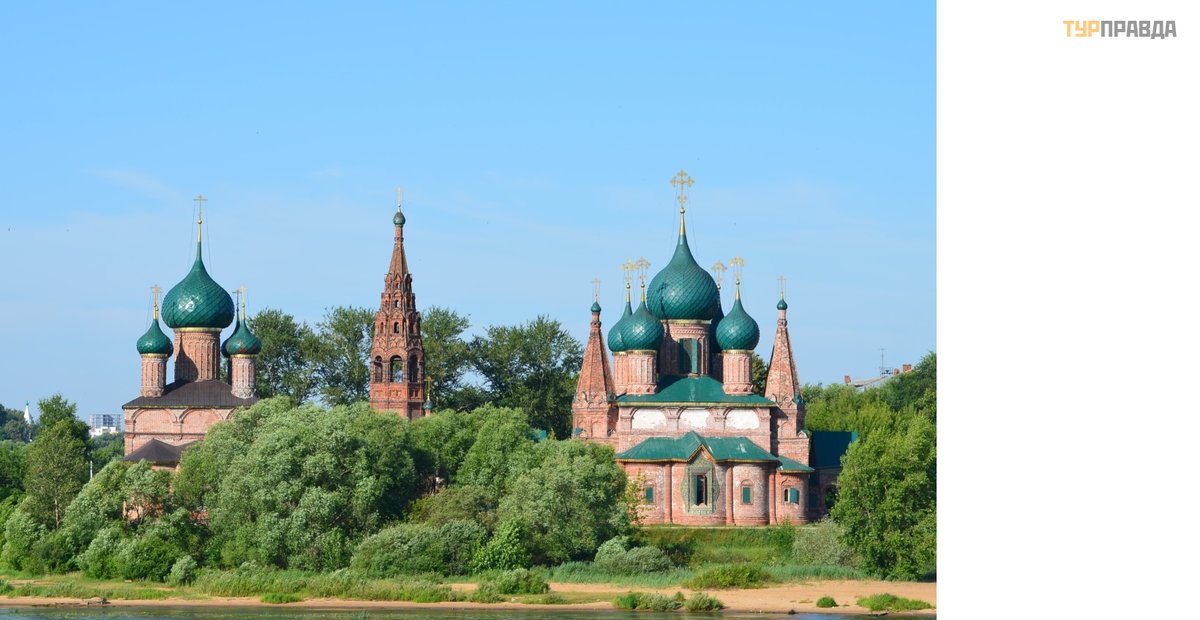 View from the Volga. Photo from the Internet
View from the Volga. Photo from the Internet
This architectural ensemble seems to be well-known, but tourists, just like in Tolchkovo, do not often favor their visits, it is far from the beaten tourist routes of Yaroslavl.
The temple complex in the Korovnitskaya Sloboda of Yaroslavl - the Church of St. John Chrysostom, the Church of Our Lady of Vladimir, the bell tower, the Holy Gates - the place is very beautiful and is a vivid example of Yaroslavl church architecture, which has come down despite all the ups and downs of the 20th century to this day .
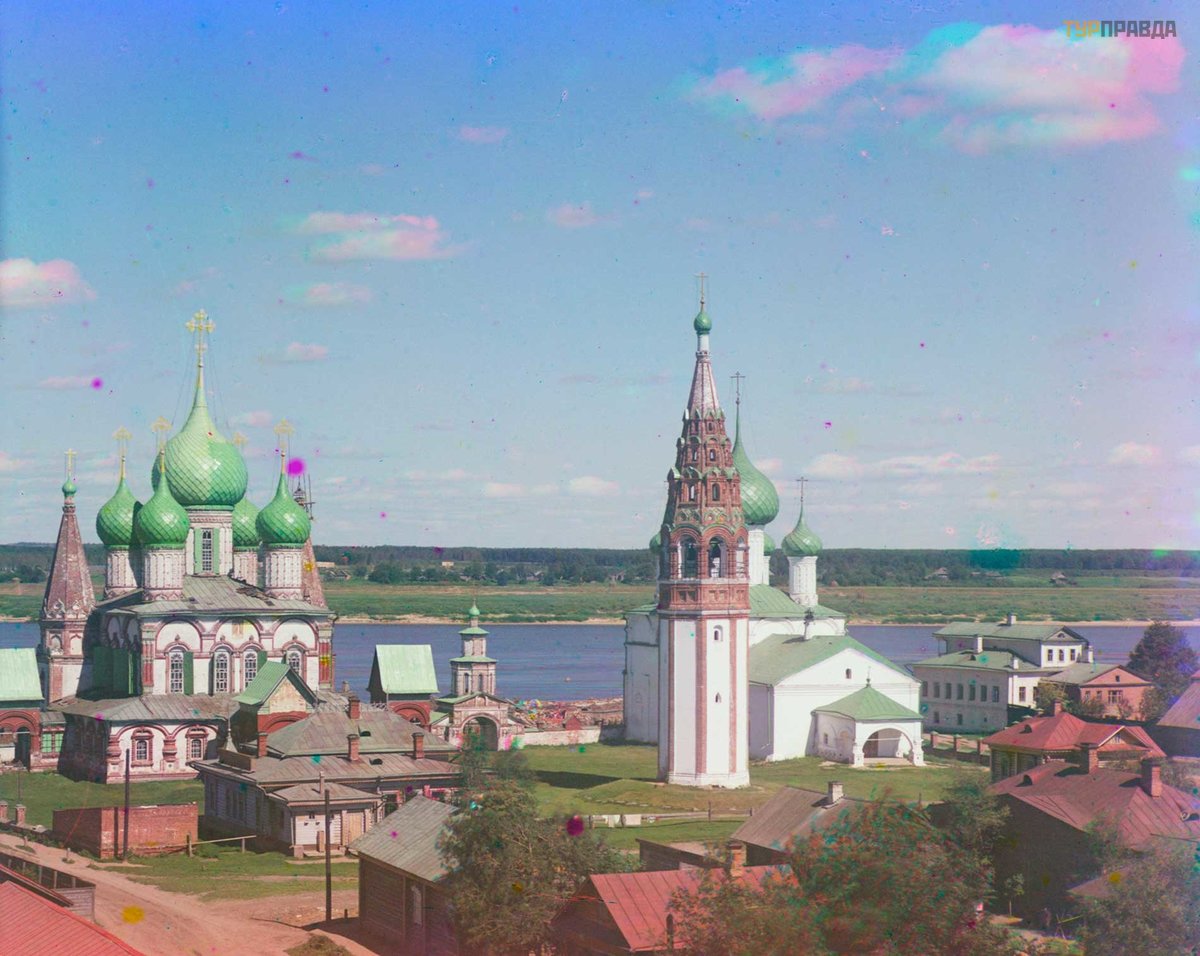 Photo from the Internet. From the collection of S. M. Prokudin-Gorsky, 1911
Photo from the Internet. From the collection of S. M. Prokudin-Gorsky, 1911
The history of most churches in our country is similar: in the 30s of the last century, the cessation of worship, then destruction, or, if you're lucky (so to speak), reprofiling into a workshop or warehouse. These churches also served as warehouses for many years. In 1992, the complex was transferred to the Russian Old Believer Church.
Why the settlement is called Korovnitskaya is not known for certain. There is no information about the mass breeding of cows as a means of earning money. Sometimes the sources call it a fishing settlement, which, in fact, is explained by its coastal location near the confluence of the Kotorosl and Volga rivers.
Currently, Cowsheds are notorious among local residents because of the SIZO located here, which, in turn, is also part of the city's history. The first buildings of the prison castle began to be built in 1800. A brief historical background can be found online, if interested, here for more details. Frankly, I learned about this neighborhood only now, when I began to study about the temples in Korovniki. And in our memory, Cowsheds are imprinted as a corner of a village view. The beach, the townsfolk melted in the sun. . .
If you knew about the presence of a "prison" history nearby, you might have walked a little along Portovaya Street. But at that moment we had other plans: first the churches, then the beach that turned up very successfully nearby. Well, like a beach... The beach is of the Central Russian type. Not the sea, of course, but very much even nothing in hot weather. And let's not wrinkle our noses, how long ago did they start hanging around overseas resorts : ))
Each decent settlement of that time (XVII-XVIII centuries) had to have its own church. And not worse than others, and preferably better. So in Korovniki in 1654, a summer unheated church of St. John Chrysostom appeared, built at the expense of wealthy townspeople Ivan and Fyodor Nezhdanovsky.
Initially, the temple was not so luxurious - an ordinary, one might say, five-domed temple with open galleries. Much later (in the 1680s), according to fashion trends, so to speak, in the architecture of that time, the building was gradually “improved”, galleries were laid, patterned porches, lace trims and original decorations with tiles appeared.
And Yaroslavl tiles are distinguished by specialists as a separate branch of ceramic art. According to the surviving historical plan of the city, by the end of the 18th century there were 19 ceramic factories in Yaroslavl, 18 of which were located in Korovnitskaya Sloboda. The temple was "brought to mind" for several decades. The main efforts were made to ensure that its beauty and magnificence were especially well visible from afar, from ships passing along the Volga. Take a look at my review of the Church of John the Baptist, built from 1671 to 1687 , compare the pictures. Sometimes the churches of John Chrysostom and John the Baptist are even confused. And no wonder. But Predtechinsky, after all, will be “more curly”, more elegant.
In 1669, a winter Church of the Vladimir Icon of the Mother of God was built nearby.
 Church of the Vladimir Icon of the Mother of God
Church of the Vladimir Icon of the Mother of God
In terms of shape and size, the building repeats the Zlatoustinskaya church. But this cathedral in its appearance is much more modest and stricter. With simplicity and grandeur, he emphasizes the splendor and elegance of the church of St. John Chrysostom, but does not look like a “simpleton” at all.
 Church of the Vladimir Icon of the Mother of God
Church of the Vladimir Icon of the Mother of God
The church is now active. We did not go inside, somehow the church search had already happened at that time, and there was no spiritual desire.
The bell tower was built just in the period of the decoration of the church of St. John Chrysostom - in the 1680s. - one for two temples. It is equidistant from both, and, as it were, binds everything into a single whole. For its elegance and harmony, the bell tower was nicknamed the "Yaroslavl Candle". On some maps, this is exactly what is indicated.
Officially, you can't climb the bell tower, but for a small fee and in the proper mood of a local worker, it turns out you can. We asked this uncle to go upstairs, but no. Apparently, we became one of the first “begging” after many months of inactivity, while it’s scary, it’s not clear what and how... But our friends were more fortunate a week later, they already managed to persuade.
The final detail of the ensemble and, indeed, linking the two temples together, are the Holy Gates. They were built on the border of the 17th and 18th centuries.
Here is such an interesting, unique temple complex preserved in Yaroslavl.
The location, of course, is not the most popular among tourists. Yes, and the locals do not particularly favor this area. But, nevertheless, along with the Church of the Beheading of John the Baptist in Tolchkovo the churches of St. John Chrysostom and the Vladimir Icon of the Mother of God in Korovniki are vivid examples of Russian, and precisely Yaroslavl architecture, that have come down to the present day. They say that their remote location from the central districts of the city made it possible to remain in almost original form, without any reconstructions and alterations. As they say, not in front of the dominant persons were...
Yaroslavl is a beautiful old Russian city. After all, it was not for nothing that it was chosen as the capital of the Golden Ring of Russia. There are a lot of Turkish stories about him. But my review is rather not about history and sights, but about how good it is when you have the opportunity to go somewhere from home : )). Yaroslavl in our case became a breath of fresh air after several months of tours. I thought here, maybe this is a kind of energy vampirism, when it is absolutely necessary to wander somewhere for a day or two, and then return home absolutely happy...
The only thing my vampire soul couldn't get was views of the city from some heights. They were not allowed to enter the belfry of the Spaso-Preobrazhensky Monastery due to coronavirus restrictions, and they also failed to climb the bell tower in Korovniki. That was not enough, the most delicious thing was not enough - when you cover everything with your eyes at once. Yes, yes, when the world is at your feet : ))
While I was looking for and copying information on the net, I came across a wonderful site about Yaro slavle. It can be very useful in preparing for a trip, and it will also come in handy when identifying already brought photos.
